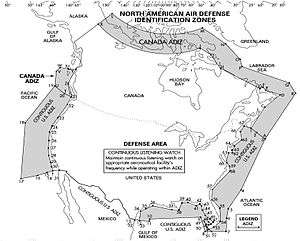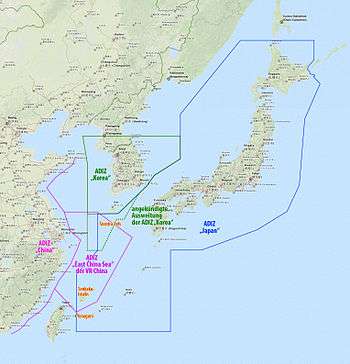Air defense identification zone
An air defense identification zone (ADIZ) is airspace over land or water in which the identification, location, and control of civil aircraft is performed in the interest of national security.[1] They may extend beyond a country's territory to give the country more time to respond to possibly hostile aircraft.[2] The concept of an ADIZ is not defined in any international treaty and is not regulated by any international body.[2][3]
The first ADIZ was established by the United States on December 27, 1950, shortly after President Truman had proclaimed a national emergency during the Korean War.[4] About 20 countries and regions now have such zones including Canada, India,[5] Japan, Pakistan, Bangladesh, Norway and the United Kingdom, People's Republic of China, South Korea, Taiwan, United States, Sweden, Iceland and more. Russia and North Korea have unofficial ADIZs as well.[1][2][6] Usually such zones only cover undisputed territory, do not apply to foreign aircraft not intending to enter territorial airspace, and do not overlap.[3][7]
Air defense zones should not be confused with flight information regions (FIRs), which are used to manage air traffic.[1]
India
India established ADIZs in the mid-twentieth century. Among other rules, notifications are required 10 minutes prior to entry. In case of delay, 45 or more minutes and a new ADC are required.[8]
India has demarcated six ADIZ near its territory. These zones have been declared over the international border with Pakistan, the international border with Nepal, over the Line of Actual Control with China, along the eastern borders with Bangladesh, Bhutan and Myanmar and two in the southern region of India.[9]
Military enforcement of ADIZs is solely the responsibility of the IAF and the task is executed through a chain of radars as well as a C3I organisation. Aircraft and surface-to-air missiles of the IAF, with elements of the Army and the Navy participating in their specific areas, where required, carry out interceptions. Civil aviation authorities, in conjunction with the IAF, also assist in this process by ensuring regulatory and control measures, such as assignment of Air Defence Clearance (ADC) numbers to aircraft entering or operating in Indian air space and by confirming the ADC of the incoming traffic, where necessary.[10]
Bangladesh
Bangladesh maintains an ADIZ that extends over the adjoining sea to the south as delineated by the following coordinates: (1) 210744.80N891356.50E (2) 181554.12N892147.56E (3) 164328.74N892554.37E (4) 201306.30N920007.60E (5) 200332.00N915031.80E (6) 175234.06N901504.66E
All flights of aircraft, civil/military, Bangladeshi or foreign, originating within the ADIZ and those penetrating the Bangladesh ADIZ shall obtain prior permission and Air Defence Clearance (ADC).
Among other procedures, aircraft flying without a valid ADC number or failing to comply with any restriction or deviating from flight plan will be liable to interception by Bangladesh Air Force.[11]
United States and Canada

The United States and Canada jointly operate an ADIZ that encompasses their sovereign airspace in North America. The United States maintains two zones in North America — the Contiguous U.S. ADIZ and Alaska ADIZ — and two more overseas — Hawaii ADIZ and Guam ADIZ.[1] Canada operates two other sections of the North American ADIZ, one off the Pacific coast of British Columbia and another that encompasses the Canadian Arctic Archipelago and its Atlantic provinces.[12]
Under US law and policy, the zone applies only to commercial aircraft intending to enter US airspace.[1] An air defense command and control structure was developed in 1950, creating five air defense identification zones around North America. If radio interrogation failed to identify an aircraft in the ADIZ, the Air Force launched interceptor aircraft to identify the intruder visually. The air defense system reached its peak in 1962. With the deployment of the SS-6 ICBM in the USSR, strategic threats shifted overwhelmingly to ICBM attacks, and bomber intrusions were considered to be less of a threat. It does apply to aircraft passing through the zone to other countries.
Japan

Japan has an ADIZ that covers most of its exclusive economic zone. Japan's ADIZ was created by the United States Armed Forces (USAF) after World War II, with the western border at 123° degrees east. This resulted in only the eastern half of Yonaguni Island being part of Japan's ADIZ and the western half being part of Taiwan's ADIZ. On 25 June 2010, Japan extended its ADIZ around Yonaguni 22 km westwards to align with its territorial waters. This led to overlapping with sections of Taiwan's ADIZ. However, Taiwanese foreign affairs officials said that it does not make any difference, as an understanding has been reached between the two parties on how to handle it.[13]
According to China Network Television on 24 November 2013, China and Russia do not recognize Japan's ADIZ.[14]
Taiwan
Taiwan has an ADIZ that covers most of Taiwan Strait, part of East China Sea and adjacent airspace, most ADIZ of Taiwan is built on its exclusive economic zone. Taiwan's ADIZ was designed and created by the United States Armed Forces (USAF) after World War II.
South Korea
South Korea operates a zone that covers most but not all of its claimed airspace.[15] It does not cover some remote spots.[15] The zone was established in 1951, during the Korean War, by the United States Air Force to block communist forces.[15] In 2013, in response to the establishment of a Chinese zone that covers disputed territory, the South Korean government considered expanding their zone to include islands of Marado and Hongdo, and Ieodo, a submerged rock within the overlapping exclusive economic zones of South Korea and China.[15]
When part of or the whole flight route of an aircraft enter the KADIZ area, it is required to send a specific flight plan one hour prior to departure. Civilian aircraft with regular routes should submit a repetitive flight plan to the air traffic control. There is no need for legal action when an aircraft enters KADIZ as long as the aircraft follows its flight plan reported to the South Korean government. If there is a change in the flight passage or an approach without prior notification, the South Korean air force has the right to immediately identify or track down the aircraft and be prepared for interception. However, military force such as shooting down the plane cannot be exercised.
On December 8, 2013, the Defense Ministry of Republic of Korea announced the expansion of the Korea Air Defense Identification Zone (KADIZ). After South Korea expanded KADIZ and China established their ADIZ in 2013, certain areas overlap with each other. The KADIZ boundary area at northwest Jeju Island (about 2,300 km2) overlaps with the East Chinese Sea. Also, South Korea's domestic aircraft cannot avoid entering China's ADIZ near Ieodo even if the flight's purpose is for rescue or searching distressed/missing aircraft. More tension is increasing as the area of South Korea, China and Japan's FIR reiterate with each other.[16] These sensitive issues are expected to bring military or diplomatic conflict between the three countries. By 29 August, Chinese military jets had entered the KADIZ area without notice five times in 2018.[17]
China
On November 23, 2013 the People's Republic of China (PRC) established a zone in the East China Sea.
The announcement of the zone drew attention and international criticism, including from most of China's East and Southeast Asian neighbors such as Japan, South Korea, and the Philippines, and as well as from the European Union and the United States. These responses focused on two related aspects: while hitherto zones had only covered territory that was undisputed at the time of their establishment, China's ADIZ in the East China Sea covers the Japanese-controlled Senkaku Islands (Diaoyu Islands in the PRC)[2] and also includes Socotra Rock, which is claimed by South Korea. Secondly, China's zone overlaps with other countries' ADIZ and imposes requirements on both civilian and military aircraft regardless of destination.[3][7]
It has been claimed that the Senkaku Islands dispute predates Japan's 1969 establishment of its ADIZ over the islands. Japan holds that there is no record of the People's Republic of China announcing a claim to the Senkaku islands in 1969 or before.[18] The PRC, on the other hand, holds that the Diaoyu Island has historically been part of China.
The Chinese government has noted that any established international limits for defining and enforcing an ADIZ are not clearly defined. Chuck Hagel, the American Secretary of Defense, while acknowledging there is nothing new or unique in establishing an ADIZ, criticized the manner in which China had acted as "unilateral", "immediate" and "without consultation".[19] American Vice-President Joe Biden made no public mention of the Chinese ADIZ following his meeting with Chinese leader Xi Jinping,[20] although elsewhere expressed concern that the Chinese move had escalated tensions in the region.
Tokyo brought the matter to the International Civil Aviation Organization, a U.N. agency to promote the safe and orderly development of international civil aviation throughout the world.[21] Australia, Britain and the United States supported Japan's proposal, but China reacted sharply against the proposal.[22]
As of December 4, 2013 some 55 airlines in 19 countries and three regions have complied with China's ADIZ rules.[23] After initial indication by South Korea's Ministry of Transport that South Korean airlines would not recognize the Chinese ADIZ,[15] South Korea's Asiana Airline and Korean Air later chose to abide by the ADIZ.[24] Japan said its airlines would not recognize the zone.
In 2014, China's Foreign Ministry dismissed reports that they were considering a similar ADIZ over the South China Sea, as the countries in ASEAN were no threat.[25]
References
- Abeyratne, Ruwantissa (2011-09-13). "In search of theoretical justification for air defence identification zones" (PDF). Journal of Transportation Security. Springer Nature. 5 (1): 87–94. doi:10.1007/s12198-011-0083-2. ISSN 1938-7741. Archived from the original (PDF) on 2014-07-09.
- Page, Jeremy (Nov 27, 2013). "The A to Z on China's Air Defense Identification Zone". The Wall Street Journal. Retrieved 29 November 2013.
- "Air Defense Identification Zone". GlobalSecurity.org. Retrieved 29 November 2013.
- R. P. Anand, Origin and Development of the Law of the Sea (Martinus Nijhoff, 1983) p171
- "Navy Closely Watching China Claims". New Indian Express. 7 December 2013. Retrieved 7 December 2013.
- Jane Perlez (27 November 2013), China Explains Handling of B-52 Flight as Tensions Escalate The New York Times
- Rick Gladstone and Matthew L. Wald (27 November 2013), China’s Move Puts Airspace in Spotlight The New York Times
- https://www.cigionline.org/sites/default/files/graduate_fellows_pb_no.1.pdf
- http://glcmumbai.com/lawreview/volume9/03JoshuaAbhayPatnigere.pdf
- "Integrated Air Defence for the Indian Airspace".
- http://www.caab.gov.bd/aip/sup/aipsup01-18.pdf
- "Designated Airspace Handbook" (PDF). Nav Canada. 25 April 2019. Archived from the original (PDF) on 16 June 2019. Retrieved 23 July 2019.
- "Japan extends ADIZ into Taiwan space". taipeitimes.com. Taipei Times. 26 June 2013. Retrieved 24 November 2013.
- "Background: Air Defense Identification Zones". China Network Television. 24 November 2013.
- "Seoul considers southward expansion of air defense zone". The Korea Herald. Retrieved 1 December 2013.
- "Air defense zones of China, S. Korea overlap", Yonhap news, November 24, 2013
- "Chinese military jet enters S. Korean air defense zone". Yonhap News. 29 August 2018.
- Bill Gertz (15 September 2010), Inside the Ring Washington Times
- "Hagel says China's way of setting up air zone was "not wise"". GlobalPost. Archived from the original on 5 February 2015. Retrieved 4 February 2015.
- "Biden Meets With Chinese President, No Public Mention of ADIZ". VOA. Retrieved 4 February 2015.
- Nicolaysen, Lars (1 December 2013). "Japan calls for action of China air zone". theaustralian.com.au. AAP. Retrieved 30 November 2013.
- "Japan seeks ICAO's involvement in tackling China's air defense zone". Archived from the original on 2014-07-15.
- "55 airlines report flight plans to China: FM - People's Daily Online". English.peopledaily.com.cn. Retrieved 2013-12-06.
- "South Korea's Asiana Airlines And Korean Air Abide By Chinese Air Defense Identification Zone (ADIZ)". International Business Times. Retrieved 8 May 2018.
- Xuequan, Mu (2 February 2014). "China dismisses ADIZ reports, optimistic about South China Sea situation". xinhuanet.com. Xinhua News Agency. Retrieved 1 February 2014.